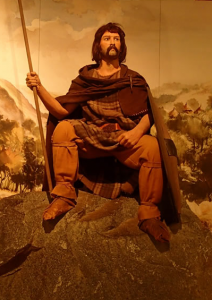Celtic Guernsey and the King’s Road Settlement
 The largest area of Celtic settlement we know of on Guernsey was to the east of King’s Road, on the outskirts of St Peter Port. But was life like for the celtic peoples of Guernsey and even who were the celts ?
The largest area of Celtic settlement we know of on Guernsey was to the east of King’s Road, on the outskirts of St Peter Port. But was life like for the celtic peoples of Guernsey and even who were the celts ?
KINGS ROAD SETTLEMENT & CEMETERY
The main focus of the settlement was below what is to today Elizabeth college’s Acorn House and the area to the south of the school buildings.
In 2005 a large Celtic roundhouse, about 8 metres in diameter, was excavated here. The postholes marking the outline of the structure could clearly be seen, cut into the gravelly natural rock. The pottery found within the roundhouse suggests that it dates from the early or middle Iron Age, perhaps the 6th or 5th centuries BC. At some later point the southern half of the roundhouse was destroyed by quarrying, probably in search of pockets of clay which are present in the gravel.
 The main area of burials lay to the west of the roundhouse. The full extent of the cemetery is not known, but it may continue beneath King’s Road and also further to the south. Because of the acidic soil only a few tiny fragments of human bone have survived, so it is usually impossible to be certain whether a grave contained a man or a woman.
The main area of burials lay to the west of the roundhouse. The full extent of the cemetery is not known, but it may continue beneath King’s Road and also further to the south. Because of the acidic soil only a few tiny fragments of human bone have survived, so it is usually impossible to be certain whether a grave contained a man or a woman.
The form of the graves was quite variable. Some had up to 3 courses of stone surrounding them. Others had no stones at all and there was no obvious link between the form of the structure and the contents of the grave. For example the richest burial had no stones around it at all, and nor did one of the warrior burials.
Some burials contain no grave goods at all, but it is possible that they originally held offerings of food, wooden items or textiles, which have not survived. Most of the burials are oriented approximately north/south. and it seems that the body was usually placed with the head to the south.
It has prived very difficult to date most of the burials, and almost impossible in the case of those without grave goods. Howevr there was one item, a bronze neck-ring, which can be fairly precisely dated to the 4th or early 3rd century BC. This dating wss based on similar objects buried in Iron Age cemeteries near Paris. Most of the other objects could date from anywhere between the 6th and 1st centuries BC.
KINGS ROAD GRAVE GOODS
The grave goods that have been discovered can reveal a fascinating insight into the technology as well as the trading networks of the Celts.
Fore example, one grave in the King’s Road cemetary, probably for a woman, contained two shale bracelets. The shale almost certainly came from Kimmeridge, in Dorset. It was probably imported to Guernsey via a site near Cherbourg, where shale rough-outs were transformed into finished items. This is a fragile, brittle material and it is unlikely that these bracelets were worn in everyday life. They may have been prized possessions of the woman who was buried in this grave, or perhaps they belonged to grieving relatives who placed them on her body when she was buried.
The three warrior burials discovered at King’s Road all include an iron sword in an iron scabbard, with a variety of accompanying items. In one of the stone-lined graves a rusty ‘blob’ in the centre was revealed to be an iron shield boss. Below it was a shield grip, and under that an iron razor. Presumably the razor was an important possession of the dead man, placed on his body in the grave, and then covered by his shield. His sword was laid alongside him, in its scabbard, at the edge of the grave.
One intriguing feature of the swords was that they were too long to have been worn as we might imagine, suspended on a belt from the waist. They must either have had some other suspension mechanism, or possibly they were never intended to be worn.
MORE WARRIOR BURIALS
Although King’s Road is the most significant Iron Age site that we know of in Guernsey, there are records of several other warrior burials from elsewhere in the island. Most of these were observed by the Lukis family in the 19th century. They include graves found at Le Catioroc and les Adams (St Peter’s), Richmond and Les Issues (St Saviour’s), and La Hougue au Comte (Castel).
Unlike the King’s Road warrior burials, some of these graves contained fine, wheel-made pottery vessels imported from Brittany. These pots are very useful as dating evidence, indicating that these burials date from the 1st century BC.






